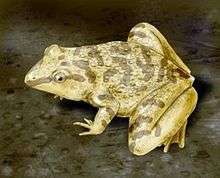Eodiscoglossus
Eodiscoglossus is an extinct genus of prehistoric frogs. It is known from the type species E. santonjae from the Early Cretaceous of Spain, as well as a referred species E. oxoniensis known from the Forest Marble Formation of the UK.[1][2][3] It was a small primitive frog, with a length of only 27 mm (1.1 in) from the premaxilla to the ischium.[2] Formerly considered to be closely related to discoglossids, now is regarded as close to the root of all extant frogs.[3] The referral of E. oxoniensis to Eodiscoglossus has been questioned, as it is much earlier than the type species and it is based on homoplasic and pleisomorphic characteristics inherited from a common ancestor, so there is no clear evidence of a close relation.[4]
| Eodiscoglossus | |
|---|---|
 | |
| Scientific classification | |
| Kingdom: | Animalia |
| Phylum: | Chordata |
| Class: | Amphibia |
| Order: | Anura |
| Family: | Alytidae |
| Genus: | †Eodiscoglossus Villalta, 1957 |
| Species | |
| |
References
- "†Eodiscoglossus Villalta 1957". Paleobiology Database. Fossilworks. Retrieved 2 March 2018.
- Hecht, Max K. (1970). "The morphology of Eodiscoglossus, a complete Jurassic frog". American Museum Novitates. 2424: 1–17. hdl:2246/2634.
- Báez, Ana Maria; Gómez, Raúl O. (2016). "Revision of the skeletal morphology of Eodiscoglossus santonjae, an Early Cretaceous frog from northeastern Spain, with comments on its phylogenetic placement". Fossil Imprint: 67–77. doi:10.14446/fi.2016.67. ISSN 2533-4069.
- Báez, Ana M.; Gómez, Raúl O. (2019). "Redescription of the overlooked basal frog Wealdenbatrachus reveals increased diversity among Early Cretaceous anurans". Cretaceous Research. 99: 14–29. doi:10.1016/j.cretres.2019.02.006.
See also
- Prehistoric amphibian
- List of prehistoric amphibians
This article is issued from Wikipedia. The text is licensed under Creative Commons - Attribution - Sharealike. Additional terms may apply for the media files.